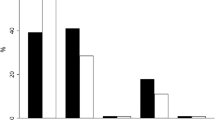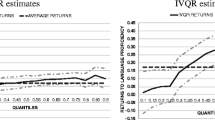Abstract
We compare literacy test scores and their impact on wage and employment outcomes of Australian, Canadian, and the US immigrants. Overall, we find little to distinguish the skills of immigrants to these three countries, although there is some indication of gains at the lower end of the distribution among Australian immigrants arriving after the mid-1990s. Relative immigrant wage returns to literacy are, however, substantially higher in the USA, which we argue reflects language-skill complementarities, as opposed to more efficient skill utilization or unobserved productivity characteristics.




Similar content being viewed by others
Notes
Note that Canada has followed the Australian lead and introduced pre-migration credential recognition systems since the data we examine were collected.
Department of Immigration and Border Protection, Immigration Update.
The International Adult Literacy Survey (IALS) was conducted in 23 countries, including Australia, Canada, and the USA, between 1993 and 1998. We were unable to use these data as only public-use files, which provide limited information on labour market earnings, were available for Australia and USA.
There is an important question about why there exists any variation in test scores among university-educated workers, given the basic skills that the test questions are intended to capture. Our understanding is that the variation is primarily a consequence of the item response theory (IRT) methodology used to estimate the test scores. In essence, estimated plausible values depend in part on the difficulty of the questions that one randomly receives. Consequently, an important part of the variation in plausible values at the upper end of the distribution is entirely random.
Insufficient sample size prohibits conducting this exercise for immigrants in the US sample. The results for Australia and Canada are available from the authors.
For Australia, the data were accessed through the Australian Bureau of Statistics’ remote access system, while for Canada and the USA, they were accessed through a secure facility approved by Statistics Canada and the National Center for Education Statistics (NCES), respectively.
While it is possible to identify whether an individual was born outside the country of interview for all three destination countries, no further information regarding country of birth is available for the USA, and in Australia and Canada the information is limited to a small set of the largest source countries.
Using Census data, we compared the top 20 foreign-language immigrant source countries based on official languages. Excluding the set of Spanish countries from the US data, the results reveal remarkable overlap in the set of countries, suggesting that US immigrants with a non-Spanish mother tongue are not substantially different in origin from Australian and Canadian immigrants with a foreign mother tongue. The results are available from the authors upon request.
Among the native-born, mean document literacy scores are similar in Australia (284.2) and Canada (286.6), but considerably lower in the USA (275.0). This difference holds across all education levels, broad occupations, and age categories.
Note that the Australian sample does not provide sufficient detail to be able to identify immigrants with a Chinese mother tongue. Consequently, for the Australian sample, immigrants with a Chinese mother tongue are identified using information on country of birth. As a result, the classification for Canada and the USA is broader, as it includes immigrants from other Asian nations, such as Malaysia, Laos, and Vietnam, who have a Chinese mother tongue.
The sample we use to estimate Eq. (1) includes all individuals that worked at least 1 h in the last year. The estimated relative immigrant returns to skill could reflect hours variation if: (i) hourly wages are increasing in hours of work; (ii) hours vary systematically with skill; and (iii) preferences for work vary between natives and non-Spanish immigrants. However, it turns out that including controls for weekly hours of work in the wage equation (1) has a negligible effect upon the estimated relative returns to skill.
A skill score of 225 is regarded by the survey developers as the ‘minimum required for individuals to meet the complex demands of everyday life and work in the emerging knowledge-based economy’ (Statistics Canada 2005, p. 35). Accordingly, individuals with a skill score below 225 would be deemed as functionally illiterate.
These results are available from the authors upon request.
Due to limited immigrant sample sizes, particularly in the US sample, we are forced to restrict the coefficients on the conditioning vector X i to be the same for immigrants and natives.
Specifically, the immigrant return to a 10-point increase in literacy is 3.6 log points, compared to 2.5 log points for natives. The p value on this difference is 0.201.
Note that language only affects wages through its ‘complementarity’ with cognitive skills. An independent return to language, say α L , would imply a value of language even in the absence of any cognitive skills, which seems implausible.
Note that this result requires that cognitive skills C i and language abilities L i are more complementary in wage determination than in the production of test scores. In the example, we present the extreme case in which C i and L i are multiplicative in wage determination, but additively separable in test score outcomes.
To see this, note that the immigrant intercept implies a wage gap of 14.9 log points at a skill level of 225. The immigrant-specific return of −0.029 means that reducing skill by 10 points serves to reduce this gap by 2.9 log points, so that it is 12 log points at a skill level of 215. Hence, the gap will be zero at a skill level 225 − (0.149/0.029) ∗ 10) = 174.
We used the 12 level descriptors identified by LaPolice et al. (2008, Table 9) as relevant for document literacy. They included three abilities (written comprehension, deductive reasoning, and information ordering); three skills (writing, active learning, and judgement and decision making); one knowledge (English language); and five work activities (getting information needed to do the job; processing information; scheduling work and activities; organizing, planning, and prioritizing work; and documenting and recording information). To collapse 6-digit occupation codes in the O*NET down to 4-digit SOC2000 codes, we took unweighted averages of each of the 12 descriptors. To collapse the 12 descriptors down to a single factor, we used principal component analysis weighting observations by occupational employment levels for the USA in 2005. Also, in some cases, there were multiple SOC2000 codes for a single ISCO88 code. In these cases, we took the average of the SOC2000 codes weighted by their employment levels.
Comparing the March 2003 Current Population Survey (CPS) with the US ALLS indicates significantly higher unemployment rates in the ALLS, particularly for the least educated native-born workers. The share of native-born workers in the least-educated group is, however, very similar in the ALLS and CPS, suggesting the difference in unemployment rates reflects measurement, as opposed to sampling, issues.
The probit estimates underlying both figures are provided in the Appendix.
References
Antecol H, Cobb-Clark D, Trejo S (2003) Immigration policy and the skills of immigrants to Australia, Canada, and the United States. J Hum Resour 38 (1):192–218
Antecol H, Kuhn P, Trejo S (2006) Assimilation via prices or quantities: sources of immigrant earnings growth in Australia, Canada, and the United States. J Hum Resour 41(4):821–40
Aydemir A (2014) Skill-based immigration, economic integration, and economic performance. IZA: World of Labour 41
Aydemir A, Skuterud M (2005) Explaining the deteriorating entry earnings of Canada’s immigrant cohorts: 1966–2000. Can J Econ 38(2):641–671
Aydemir A, Skuterud M (2008) The immigrant wage differential within and across establishments. Ind Labor Relat Rev 61(3):334–52
Barrett G (2012) The return to cognitive skills in the Australian labour market. Econ Rec 88(280):1–17
Berman E, Lang K, Siniver E (2003) Language-skill complementarity: returns to immigrant language acquisition. Labour Econ 10:265–290
Blau FD, Kahn L (2005) Do cognitive test scores explain higher U.S. wage inequality? Rev Econ Stat 87(1):184–93
Borjas GJ (1987) Self-selection and the earnings of immigrants. Am Econ Rev 77(4):531–553
Bratsberg B, Hægeland T, Raaum O (2013) Immigrant skills and employment: cross country evidence from the adult literacy and life skills survey. Statistics Norway research department discussion paper, No. 730
Clarke AJ, Skuterud M (2013) Why do immigrant workers in Australia perform better than those in Canada? Is the immigrants or their labour markets. Can J Econ 46(4):1431–1462
Cobb-Clark DA (2003) Public policy and the labor market adjustment of new immigrants to Australia. J Popul Econ 16:655–681
Dechief D, Oreopoulos P (2012) Why do some employers prefer to interview Matthew, but not Samir? New evidence From Toronto, Montreal and Vancouver, CLSRN Working Paper, No.95
Ferrer A, Green DA, Riddell WC (2006) The effect of literacy on immigrant earnings. J Hum Resour 41(2):380–410
Green DA., Riddell WC (2003) Literacy and earnings: an investigation of the interaction of cognitive and unobserved skills in earnings generation. Labour Econ 10 (2):165–184
Gregory RG (2014) The two-step Australian immigration policy and its impact on immigrant employment outcomes. IZA discussion paper No. 8061
Hanushek EA, Schwerdt G, Wiederhold S, Woessmann L (2015) Returns to skills around the world: evidence from PIAAC. Eur Econ Rev 73:103–130
Kahn LM (2004) Immigration, skills and the labor market: international evidence. J Popul Econ 17(3):501–534
LaPolice C, Carter GW, Johnson JW (2008) Linking O*NET descriptors to occupational literacy requirements using job component validation. Pers Psychol 61:404–441
Oreopoulos P (2011) Why do skilled immigrants struggle in the labor market. Am Econ J Econ Pol 3(4):148–171
Pendakur K, Woodcock S (2010) Glass ceilings or glass doors: wage disparity within and between firms. J Bus Econ Stat 28(1):181–189
Richardson S, Lester L (2004) A comparison of Australian and Canadian immigration policies and labour market outcomes, Department of Immigration and Multicultural and Indigenous Affairs, Canberra
Statistics Canada (2005) Learning a living: first results of the adult literacy and life skills survey, minister of industry, Canada and Organisation for Economic Cooperation and Development (OECD), Paris
Acknowledgments
This paper was completed while Andrew Clarke was a visiting scholar in the Office of Population Research, Princeton University. Their hospitality, and in particular the generous hospitality of Marta Tienda, is gratefully acknowledged. Mikal Skuterud acknowledges financial support from the Social Science and Humanities Research Council of Canada (No. 410-2011-0281). We thank the Editor of this journal and two anonymous referees for their numerous helpful comments.
Author information
Authors and Affiliations
Corresponding author
Additional information
Responsible editor: Klaus F. Zimmermann
Appendix
Appendix
Rights and permissions
About this article
Cite this article
Clarke, A., Skuterud, M. A comparative analysis of immigrant skills and their utilization in Australia, Canada, and the USA. J Popul Econ 29, 849–882 (2016). https://doi.org/10.1007/s00148-016-0591-2
Received:
Accepted:
Published:
Issue Date:
DOI: https://doi.org/10.1007/s00148-016-0591-2




